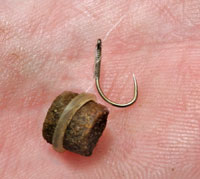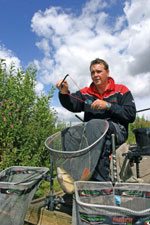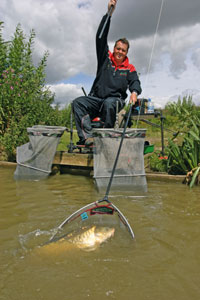Once carp start competing up in the water a good weight should almost be guaranteed and, for me, there is no better combination for this than the pole and pellets.
Fishing pellets shallow on commercials is a match-winning method that rewards anglers who are prepared to work hard for their bites. Once you have mastered feeding and presentation the rewards should more than repay the effort involved.
Bait
Pellets must undoubtedly rate as the best all-round bait for targeting carp up in the water. Hard, unsoaked pellets are generally best and more and more these days I opt for larger 6mm pellets as opposed to the more-traditional 4mm size. The reason is because they fire out easier in a wind, can be grouped tightly and make a louder, fish-attracting noise on impact. They also attract less attention from nuisance smaller fish. On top of this, I find you can get away with feeding far fewer 6mm pellets each cast compared to using 4mm versions so, with less offerings going in the chances of a carp taking your hook bait are increased.
Obviously, fishery rules may dictate the exact pellets you can use but where possible I prefer to use 6mm BCUK Grub pellets as they very consistent in shape. I am not that concerned about pellet colours or shades, because I firmly believe it is the noise value that is most significant.
I like to use exactly the same pellets for both feed and hook so the banded pellet complements the feed perfectly. I will also have a few expander pellets on my side tray to try, just in case. With expanders it often pays to soak but not pump them so they only just sink with the weight of your hook inside.
Where To Fish
This is down to common sense really but you should always pick a comfortable distance for the conditions you are faced with, so you can feed and control your rig easily. Generally, a distance of about 11 to 13 metres is okay but it can depend on how far out the anglers around you are fishing. Try to fish the same distance as those around you or, if possible, a section further out.
It can pay to have several rigs assembled at different depths, from 12 inches to as much as four feet, and alternate between them. The fish don’t always want a static bait suspended up in the water so even if the fish are at 18 inches, for example, you may be better off regularly laying in a 3ft rig to fool them.
Feeding
I generally like to feed up to a dozen pellets at a time but I will feed heavier at the start to try and draw everyone’s fish in front of me. Once the carp are there I reduce the amount of pellets fed so the fish start competing harder. Feeding more bait when the fish are not there is a good pattern to follow.
Firing in a regular stream of pellets helps but you DON’T have to feed continuously. By stopping feeding now and then the only pellet the fish will find is the one on your hook. Don’t stop feeding for too long, however, or else the fish could drift away.
 |
| Jamie tends to fish banded 6mm pellets. |
Feeding while you are playing a fish is another skill worth mastering because, in match conditions, the next fish is just as important as the one you are playing. By feeding while you are playing a fish you are priming the swim for the next bite, which should save you precious time in the long run. I like to feed immediately after hooking a fish and then feed again before and/or after netting a fish.
Make Some Noise!
Shallow fishing is most effective when the fish respond to the noise and vibrations of your feed hitting the water. Increase the noise factor by using a small bulk of shot a few inches from the hook which helps creates a ‘double splash’ when you slap the rig on the water. Sometimes doing this several times in quick succession before letting the rig settle can be really effective.
Where allowed, you can also reinforce this effect by occasionally tapping the water surface with your pole tip. If the fish respond to this the results can be devastating!
Tackle
I like to use a short, dibber-type float for depths up to 12 inches and a bristled pattern for depths greater than this. The typical patterns I use are either a 0.2g Maver Jurassic dibber for shallow water, a 4×10 or 4×12 Black Ice Chop for up to three feet and a more stable Black Ice Polar with a wire stem for ‘deep-shallow’ work up to four feet. Each float is typically shotted with a bulk of shot about a third of the way from the hook with a No10 under the float to help cock it.
 |
| Keep making a noiise by feeding, even with a fish in the landing net. |
I like to use No12 latex for most shallow fishing situations but will step up to orange Maver Dual Core for really big fish. It is important to not set your elastics too tight because you should ease the fish out of the swim with the least amount of commotion.
My preferred hook is generally an eyed size 16 Maver MT4. Line is 0.14mm Genesis Extreme straight through or 0.16mm if I’m bagging. How much line you have above your float depends on the conditions but the shorter the better, as this increases the chance of a fish hooking itself on the take.
Thanks to Woodlands Lakes, near Thirsk, for the use of their fishery. Telephone 01845 526110.
Jamie Masson’s Top Tips:
Pick a comfortable distance according to conditions
Make some noise to draw in the fish
Try using hard 6mm pellets instead of 4mm
Try to use the same bait banded on the hook as you are feeding
Feed heavily at the start
Reduce the amount you feed once the fish arrive
Occasionally stop feeding so your hook bait is the only bait available
Have several rigs set up at different depths
Use dibbers for shallow water and bristled floats for deeper water
Shot your floats with a bulk at a third depth
Slap the rig on the water to attract the fish
Try tapping your pole tip on the water if allowed
Softly set No12 elastic helps avoid any commotion
Feed while playing a fish and immediately after netting it






